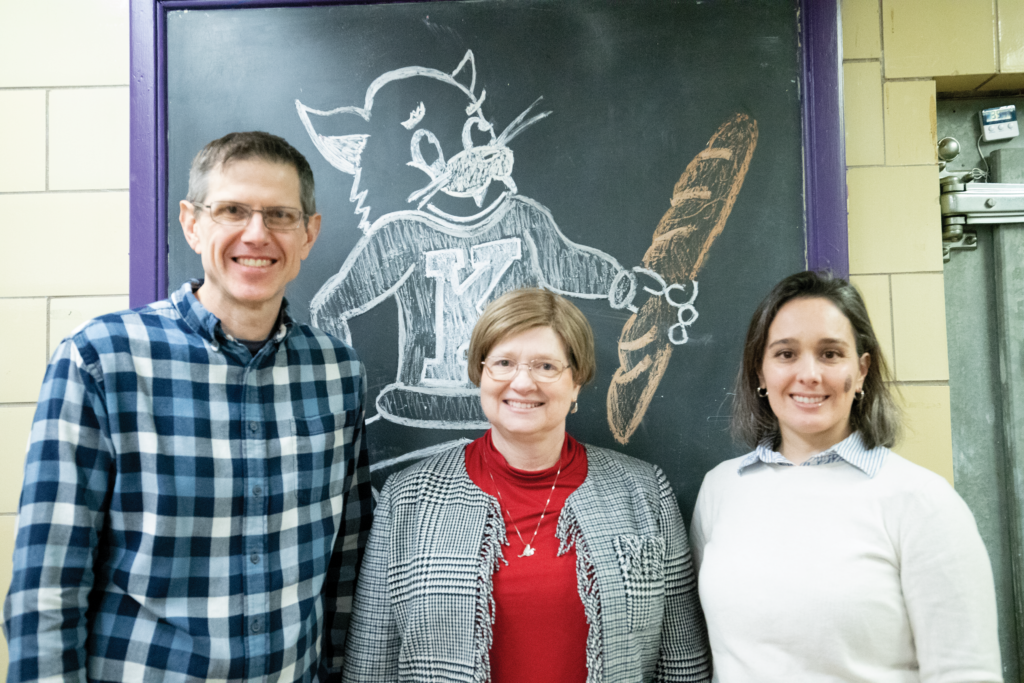K-State trio evaluates soy ingredient usage
Multi-faceted project focuses on students’ perception changes
Kansas State University students working their way through food science and bakery science studies are sure to know more about soybeans — and the ingredients that come from this versatile crop – before entering the workforce. This is thanks, in part, to three professors specializing in food science, baking and product development.
Dr. Kelly Getty, associate professor in Animal Sciences and Industry; Dr. Elisa Karkle, assistant professor in Grain Science and Industry; and Aaron Clanton, Bakers National Education Foundation instructor; teamed up to execute a multi-faceted project funded by the Kansas Soybean Commission. Enhancing Consumers’ Perceptions of Soybean-based Ingredient Uses combines education, research and laboratory exercises to positively impact students’ perceptions of soy as a reputable food ingredient.
By the end of year two, “One very clear outcome that we expect is students who are trained on soy ingredients,” Getty says. “Students know what these ingredients are and how to use them. They know how the ingredients function and how to apply them in the industry. It should help break perceptions from years ago that soy products are not effective.”
Getty’s portion of the project focuses on education.
“The idea for the project started five years ago,” Getty shares. “We wanted to develop modules for college students in my Fundamentals of Food Science course that focuses on soy ingredients followed by an exercise where the students make a muffin with soy flour or a soy protein isolate.”
Getty then adapted those modules for high school classrooms and the teachers leading those classrooms. It has reached about 750 students in total.
Students in Getty’s product development course during the fall semester created three new dishes with soy protein and trialed those recipes in Kramer dining hall on campus. The lasagna featuring texturized soy protein, pho bowl featuring protein-rich noodles and seasoned tofu and vegan sunrise bowl featuring texturized soy protein were met with positive reviews from the nearly 80 students who tried them, Getty says. She hopes the items get a more permanent spot in the dining hall rotation.
Karkle’s segment of the project involves some teaching through the Bakery Science II course and its unit on lecithin as an emulsifier.
“We talk about the science behind lecithin – how it’s obtained, how it reacts, the different types and the hydrophilic-lipophilic balance,” Karkle explains. “Lecithin is often seen as one thing but it’s a whole family of ingredients. We want the bakery science students to understand that because they become the decisionmakers for food companies.”
Karkle also conducts research on soy protein isolate applications in dough and how using a powder or nugget form changes certain dough properties. She says that breads labeled in the grocery store as “high protein” contain many legumes but not often soy.
“Of course there is the perceived allergen issue, but if you’re using multiple legumes and grains and none of them are soy?” she questions. “I think that addresses the perception piece of this project. Some of this current generation of researchers have the perception that soy is an allergen and has no positive characteristics for baking. I remember hearing as a student years ago that using soy protein makes dough tough and crumbly, so now we are asking why this is the case?”
This led to her exploration of how powdered soy protein isolate and texturized soy protein react with gluten proteins in bread dough. What Karkle has learned so far is that using the powder form leaves the protein available to interact with the gluten, thus restricting dough expansion. The soy protein binds with gluten instead of allowing gluten to bind with gluten. Localizing that same soy protein – or using it in a textured form – allows the dough structure to flow as it should with no negative impacts, she says.
Next in the research pipeline is microscopy testing to further evaluate ratios of each soy protein form in bread structure followed by sensory testing of the bread texture for consumers.
Clanton’s piece of the project is application-based. The Fundamentals of Baking course is just in its fourth year as an introductory elective open to anyone across campus. Students taking the class this semester can look forward to testing tofu as a fat replacer in biscuits.
“One of the labs we do is a fat variation, like shortening, butter, margarine – which can be soy-based,” Clanton explains. “I choose to use biscuits for that unit. One thought was that some people like to aim for reduced fat, so what about using tofu as a fat replacement?”
This lab exercise was inspired by a graduate student working with both Getty and Clanton. While in the product development class, this student looked at various techniques to incorporate tofu as a fat in biscuits and evaluated methods of draining moisture out and cutting the tofu to reach the best results. It turned out grated tofu offered the best size for the biscuit dough. This initial testing also led to the determination that a full replacement lost some flavor and an 80-20 percent tofu to margarine ratio better met palatability standards.
Now this exercise is set to be replicated in the lab by Clanton’s students for the first time this semester. It is yet to be determined if the students will work with a full or partial fat replacement, he says.
“I try to do different ingredient variations so the students see different products and ingredients and learn how they function,” Clanton says. “There seems to be all kinds of trends right now where consumers are looking for this or that replacement. Tofu in biscuits seemed like an interesting one to try.”
Many students taking the course, Clanton adds, are agricultural education students who can further replicate the laboratory exercises with their future students and explain the full cycle of how ingredient products are made.
While the exact nutritional insights have not been determined for the biscuits, Getty estimates the recipe would increase protein content while decreasing calories.
She adds, “One thing with students sometimes is that they look at ingredient variations like ‘surely there’s a way I can make this taste better,’ then there’s our professional understanding that we want the exercise to be an experimental design where students see ‘when you add tofu, this exactly what happens.’ We are using two types of soy products. The main issue with tofu as a full fat replacer to boost the protein content was getting enough moisture out of the tofu.”
Soybeans have a unique power to be well-positioned in every type of consumer diet. Animal agriculture remains the number one consumer of soybean meal, meaning the pork, beef and chicken enjoyed by many made it to the table because of soybeans. For those consumers looking elsewhere for protein, soybeans offer a plant-based solution that touts all nine essential amino acids.
The Enhancing Consumers’ Perceptions of Soybean-based Ingredient Uses project is in its first year. In December, Commissioners voted to extend the project into a second year set to align with KSC’s 2026 fiscal year. The trio looks forward to applying more of the knowledge gained from this first year to ramp up undergraduate experiences.
When asked what the project means for soybean growers, “well, it’s not increasing yield,” Clanton laughs. “But it helps consumers understand where their food comes from. It helps with the perception piece for those students that may end up teaching these fundamentals to their students. Many producers care about yield, inputs, prices, but may not always think about what happens next.”


